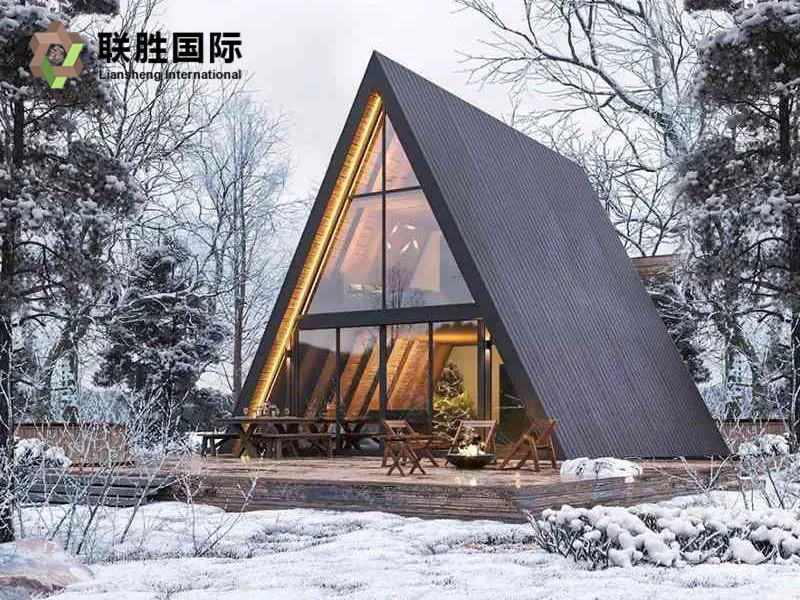Why Are A-Frame Triangle Prefab Houses the Future of Sustainable Living?
2024-11-18
In the ever-evolving world of architecture and housing, A-frame triangle prefab houses have emerged as a stylish, sustainable, and practical option for modern homeowners. But what exactly makes them so appealing, and why are they becoming the go-to choice for those seeking a unique and eco-friendly home?
What Is an A-Frame Triangle Prefab House?
An A-frame house is defined by its distinctive triangular shape, with steeply angled walls that form the roof. When combined with prefabrication techniques—where components are built off-site and assembled on location—it results in a home that is both efficient and aesthetically striking.
What Are the Advantages of A-Frame Triangle Prefab Houses?
1. Quick and Easy Assembly
Prefab construction significantly reduces building time. With components manufactured off-site, assembly can often be completed in weeks rather than months.
2. Cost-Effective
Prefabrication helps minimize labor costs and material waste, making A-frame homes an affordable alternative to traditional construction.
3. Energy Efficiency
The A-frame design naturally promotes energy efficiency. The sloped roof allows for excellent insulation, and large windows often integrated into the design provide natural light, reducing the need for artificial lighting and heating.
4. Durability and Weather Resistance
The triangular shape of A-frame houses allows them to shed heavy rain or snow easily, making them ideal for regions with extreme weather conditions.
5. Eco-Friendly Construction
Prefab processes often use sustainable materials and minimize waste, while the compact and efficient design of A-frame houses reduces their environmental footprint.
6. Unique Aesthetic Appeal
The minimalist, geometric style of A-frame houses creates a timeless and modern look that blends beautifully into natural settings, making them a popular choice for vacation homes or retreats.
What Are the Common Uses of A-Frame Triangle Prefab Houses?
- Vacation Homes: Perfect for cabins or lakeside retreats, offering cozy and functional spaces to relax.
- Tiny Homes: The compact design suits minimalist living trends and off-grid lifestyles.
- Primary Residences: With customizations, A-frame prefab houses can accommodate families while maintaining their modern aesthetic.
- Rental Properties: Their unique design and charm make them a hit with travelers seeking memorable stays.
What Should You Consider Before Buying or Building One?
1. Size and Layout
Though A-frame houses are often compact, prefab options come in various sizes. Consider your space needs, including bedrooms, living areas, and storage.
2. Location
The A-frame design suits specific environments, such as wooded areas or mountain regions. Ensure the site complements the structure and allows for proper drainage.
3. Customization Options
Many prefab manufacturers offer customizable features, such as additional rooms, solar panels, or upgraded materials.
4. Budget
While prefab homes are generally affordable, added customizations and delivery costs can influence the final price.
5. Building Permits and Regulations
Check local building codes and zoning laws to ensure your prefab home meets all requirements.
Why Are A-Frame Triangle Prefab Houses Becoming So Popular?
The rise in interest in A-frame prefab houses reflects broader trends toward sustainability, affordability, and minimalist lifestyles. They offer an ideal solution for individuals looking to downsize, embrace eco-conscious living, or build a distinctive and functional home in less time.
Tips for Designing Your A-Frame Prefab House
1. Optimize Natural Light: Large windows or skylights enhance energy efficiency and create an open, airy feel.
2. Choose Durable Materials: Opt for materials like metal roofs and treated wood for longevity.
3. Incorporate Outdoor Living Spaces: Decks and patios expand the usable area and connect the home to its surroundings.
4. Plan for Storage: Utilize built-in furniture or multi-functional spaces to maximize the interior layout.
Conclusion
A-frame triangle prefab houses offer a harmonious blend of design, functionality, and sustainability. Whether you're building a getaway in the mountains or a minimalist urban home, these innovative structures are paving the way for the future of housing.
Would you consider an A-frame prefab house for your next home project? Share your thoughts in the comments!



